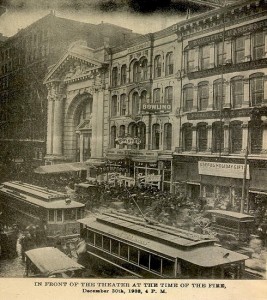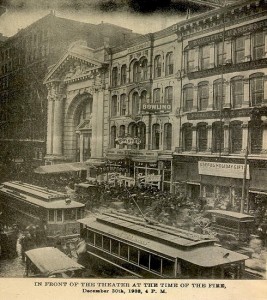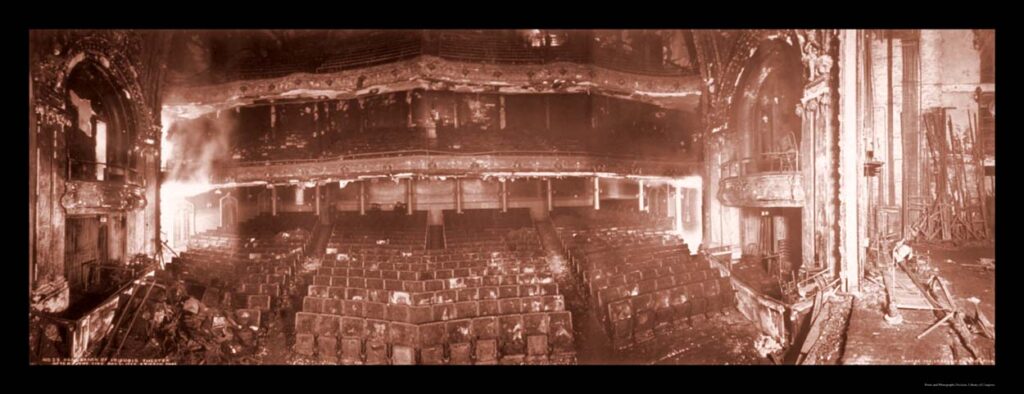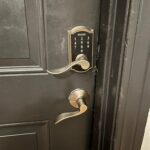This article was written by Carl Prinzler, one of the creators of the original exit device, at the end of the 1930’s. I think it’s an interesting insight into the development of the first exit device and the code requirements at that time.
How It All Began
A rambling story of the birth of Von Duprin Self-Releasing Fire and Panic Exit Devices
 On December 30, 1903, Five Hundred and Ninety-six (596) lives were lost in the Iroquois Theatre Fire, Chicago, Illinois. That alone was enough to startle the nation, let alone the hardware men who stood by idly with no solution, nothing to prevent the recurrence of so terrible a catastrophe.
On December 30, 1903, Five Hundred and Ninety-six (596) lives were lost in the Iroquois Theatre Fire, Chicago, Illinois. That alone was enough to startle the nation, let alone the hardware men who stood by idly with no solution, nothing to prevent the recurrence of so terrible a catastrophe.
On January 14, 1908, the Lakeview School at North Collinwood (Cleveland) Ohio, burned, One Hundred and Seventy-four (174) children losing their lives. By that time we felt something MUST be done! We had in mind several things that could be done, but we weren’t satisfied. In other words, to the writer, it was a case of FIGHT. In the earlier days of the Builders’ Hardware game, we had met many problems, for which we usually had a solution. As a general thing, we turned the problem over to our friendly factories, who made the item for us; we sold it, got our money, and we were happy.
But here was a situation confronting us that meant we must do something today to prevent such horrible catastrophies as these. So finally, after a number of experiments, and expensive ones, we hit upon the idea that the writer thought would be a “boon to humanity.”
Being a “boon to humanity” is like many other things. Unless the matter is placed before the Public in such a way that people realize what it is all about, it means nothing. We consequently started out with a plan of educating the world on something that would help.
We had an item which was universally accepted. We put every energy behind it. In a few months this item revolutionized Safe Exit in the School.
From a small four-page circular, describing all the devices, we have built up catalog after catalog to include the ever-growing line. Many architects have had their own ideas, and we have worked steadfastly with them to develop these ideas.
 For each case we found which looked as if it might have a future, we conscientiously set about finding some way to cover each and every condition. Consequently our line went from two devices of the Old Type “B” to twenty-six different types of devices today, each one of them having the same specific duty to perform and that is – quick exit. We are sometimes asked “Why so many types?” Our answer is “No one or ten devices will satisfactorily cover all conditions – any more than one size shoe will fit every foot.”
For each case we found which looked as if it might have a future, we conscientiously set about finding some way to cover each and every condition. Consequently our line went from two devices of the Old Type “B” to twenty-six different types of devices today, each one of them having the same specific duty to perform and that is – quick exit. We are sometimes asked “Why so many types?” Our answer is “No one or ten devices will satisfactorily cover all conditions – any more than one size shoe will fit every foot.”
Our contention is, and always will be, that a double acting cross bar is the most important thing of all, for the reason that statistics show and (and there is no one who can explain it) that people making a rush for the exit doors usually fall at the doors themselves, many piling up against the doors.
Someone with super-human strength had to pull on a cross bar rather than push on it to release the latches from their housing. That is why double acting cross bars were originated. That has never been a question up to this day but that we were right in our theory. Some situations were terrible; as time went on, buildings which were not completely equipped were proven a menace to humanity. On March 25, 1911, a few short years after Von Duprin devices were put on the market, a fire started in a shirtwaist factory in New York City, which was responsible for the loss of One Hundred and Forty-six lives.
Through this fire, history was built. Yet in spite of what happened there, scarcely a city in the United States today has a law (and that applies to States also) governing this one feature, that is that all doors should, and must be equipped.
In the case of the shirtwaist factory fire, it was shown that the two owners were told months before to equip their doors with Self-Releasing Devices. The doors were not equipped, so after this terrible catastrophe occurred, these two men were placed in custody, tried, and found guilty of murder in the first degree. It goes to show that any official, of any building housing groups of people, not completely equipped with Self-Releasing Fire Exit Devices, could be held responsible for negligence resulting in injury or death.
In that particular case One Hundred Forty-Six (146) girls lost their lives, leaving their families to mourn. The very thought makes one shudder, so the writer’s claim is that when buildings housing any number of people are not equipped, the entire responsibility rests upon the officers who know of such devices and do not use them.
Statistics also show that in 1935, as late a day as that, there were 1,800 schools burned in the United States. This is the approximate average per year. We have no record as to how many lives are lost, but the eighteen-hundred-per year figure is reliable, being that of the National Fire Protection Association.
Needless to say, our business has grown by leaps and bounds. We are striving all the while to make devices better! Price must be forgotten when high grade goods are wanted. In the end the best devices, properly applied, cut the maintenance cost to nil and give everlasting service – “Eternal Vigilance.”
Our catalogs will be cheerfully forwarded to anybody who might be interested. We are just beginning in this field; the surface has been scarcely scratched. One State after another is asking for this kind of equipment, even though there are no State Laws to cover it. Some States have a feeble suggestion at adequate laws, but the demands are not sufficient to make each and every building “panic safe”.
The fact is sometimes overlooked that it is necessary for the panic stricken person to find the cross bar, which we claim should be made of polished bronze or brass, something that can be easily seen in the darkest hallways. Then, if they do not find the cross bar with their hand, the “powers that be” give them enough equilibrium to strike this cross bar with their body and the trick is done.
Carl Prinzler
Iroquois Theatre, Chicago Illinois, 1903
You need to login or register to bookmark/favorite this content.







Lori, can you tell me the title of the publication in which this article appeared? I’d also be curious to know the month and year.
Hi Evan –
Unfortunately I don’t know when it was written and for what purpose. I found it as a 1-page handout that we were using for a history presentation. My guess is that it was between 1936 and 1940.
– Lori